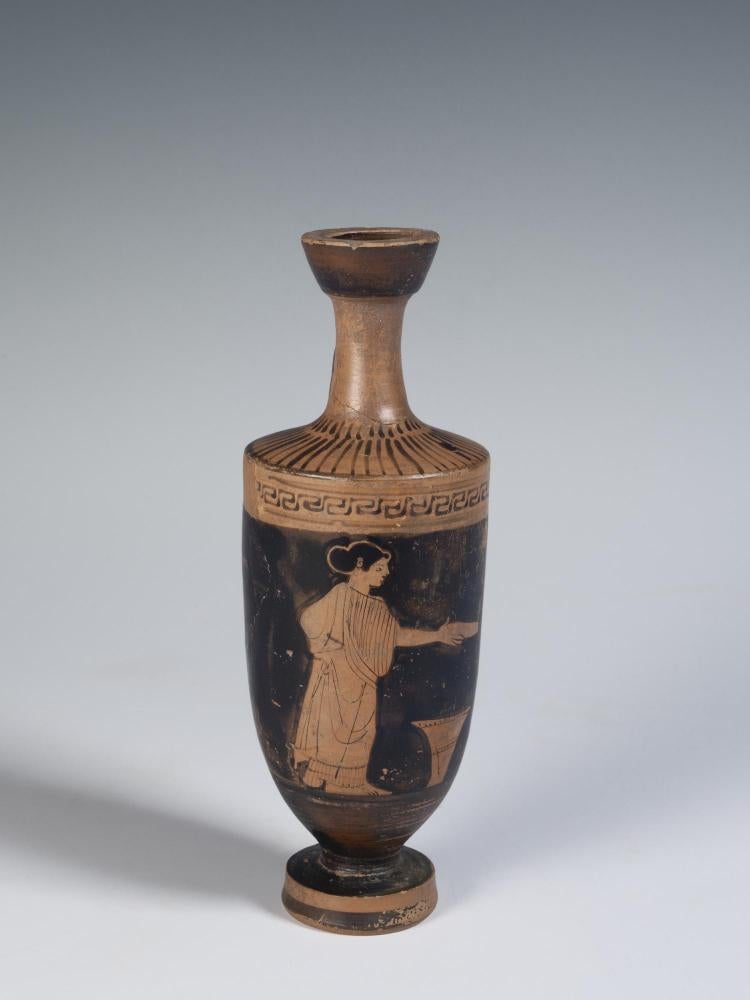2006.18.T, Attic Red-Figure Lekythos
Catalogue Entry 

This vase is one of a collection of Greek vases held by the CU Art Museum.
Gift to CU Classics Department
Transferred to CU Museum of Natural History
Transferred to CU Art Museum (2006)
Height: 16.2 cm
Diameter (max.): 5.7 cm
Date: c. 425-350 B.C.E.
Origin: Athens (Greece)
Description: small red-figure lekythos with image of woman on one side of body. The woman is holding shallow dish (phiale) over a wool basket. Meander border at top of main scene on body. Shoulder of vessel decorated with parallel vertical black lines. Neck left undecorated. Lip and mouth of vessel, as well as single handle, covered in black slip.
Additional photos of this vessel show details of the mouth, rim, handle, decoration, and base.
Discussion
A lekythos is a vessel used to store oil used for religious or funerary purposes. This lekythos is the CU Art Museum's only example of a vase decorated in the red-figure technique. The vase is made of a light red clay, while the background of the vase, decorative elements, and details were added in a black slip. The single handle on this vase is decorated with black slip on its top, exposed surface and is left in the color of the clay on its underside. The lip and mouth of the jar are covered in black slip. Short, parallel vertical lines encircle the base of the neck, while another series of longer lines decorates the shoulder of the vessel. A single band of meander wraps around the top of the vessel's body above the figural panel. This same combination of decorative elements -- two rows of parallel vertical lines and a meander -- is seen, also, on a black-figure lekythos in the CU Art Museum's collection.
The body of this vessel features a single human figure, a woman, who stands and faces right. Her thick, black hair is tied into a bun at the back of her head, with her ear placed high on her head.

The woman on the vase is identified by her dress and hairstyle, as well as by the attributes of the phiale and the wool basket, as a housewife or an otherwise generic citizen woman. The phiale in her hand suggests that she is pious, while the wool basket demonstrates her dutiful and resourceful nature.
Women in ancient Greece were relatively constrained in their roles as citizens, non-citizen residents, or slaves. According to much modern scholarship, there was little overlap within the established class structures. Regardless of her status, however, women shared similar duties, the most important of which may have been wool working and weaving. A respectable woman, such as the one on this lekythos, would spend much of her day spinning wool, a task that contributed to the household economy in a variety of ways. Today, four spinners working on wheels create enough wool for one weaver to stay busy, which means that for every one textile created, it takes four times the work to create the yarn for that woven fabric. The spinning wheel, however, was not invented until the 16th century C.E. and it would have taken a Greek woman somewhat longer to spin the same amount of wool using a drop spindle.
Few examples of textiles from ancient Greece survive and much of our evidence for the industry comes from references in texts, as well as representations on vases, stelai, and wall paintings.
Comparanda
- Marathon, Marathon Museum K331 (1)
- 475-425 B.C.E. red-figure lekythos
- Similar shape to foot and lip/shoulder tilt
- Similar decoration (i.e., meander technique and horizontal line) at shoulder and neck
- Similar style red-figure technique and execution
- Cracked at same point, suggesting similar clay grade and/or throwing technique (?)
- Athens, National Archaeological Museum 17291 (2)
- 475-425 B.C.E. red-figure lekythos attributed to the Bowdoin Painter
- Similar shoulder, neck, and lip execution
- Similar use of groundline
- Athens, National Archaeological Museum 17280 (3)
- 475-425 B.C.E. red-figure lekythos
- Similar shoulder, neck, and lip execution
- Similar curvature of foot
Footnotes
- Corpus vasorum antiquorum: Greece Fasc. 7, Marathon Museum (Athens: Academy of Athens, 2001): 63-64, 82, Fig. 43, Pl. (402) 35.1-2.
- Semni Karouzou, Corpus vasorum antiquorum, Greece, Fasc. 1, Athens National Museum (Paris: Librairie ancienne Honoré Champion, 1932): III.IC.9, Pl. (70) 12.1.
- Semni Karouzou, Corpus vasorum antiquorum, Greece, Fasc. 1, Athens National Museum (Paris: Librairie ancienne Honoré Champion, 1932): III.IC.9, Pl. (70) 12.3-4.
References
- John Boardman, Athenian Red-Figure Vases: the Archaic Period (London: Thames & Hudson, 1975): 216.
- John Boardman, Athenian Red-Figure Vases: the Classical Period (London: Thames & Hudson, 1989).
- Simon Hornblower and Antony Spawforth, eds. The Oxford Classical Dictionary, 3rd ed. (Oxford: Oxford University Press, 2003).
- Chara Tzavella-Evjen, Greek and Roman Vases and Statuettes from the University of Colorado Collection (Athens: Archaiologikon Deltion, 1973): 192-197.

